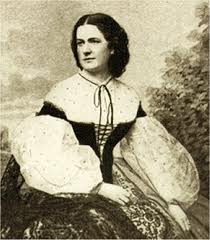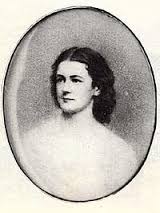 Baltimore Beauty, Hetty Cary, was not only drop dead gorgeous, but with her brown eyes, auburn hair and flawless complexion, Hetty undoubtedly had the kind of looks to turn men’s heads and was definitely an example of the true Secession Belle. Hetty smuggled herself and her sister, Jenny, out of Baltimore. Later, the two girls and their cousin, Constance, made the first Confederate Battle Flags after the Battle of Bull Run. The trio was referred to as the “Cary Invincibles.”
Baltimore Beauty, Hetty Cary, was not only drop dead gorgeous, but with her brown eyes, auburn hair and flawless complexion, Hetty undoubtedly had the kind of looks to turn men’s heads and was definitely an example of the true Secession Belle. Hetty smuggled herself and her sister, Jenny, out of Baltimore. Later, the two girls and their cousin, Constance, made the first Confederate Battle Flags after the Battle of Bull Run. The trio was referred to as the “Cary Invincibles.”
She was born on May 15, 1836, either in Baltimore or near that troubled city. Her Virginian family claimed kinship with the famous Jeffersons and Randolphs. In 1842, when Hetty was 6 year old, the family opened a girls’ academy, The Southern Home School, at Haystack. Four years later Hetty’s father won election to the Maryland state senate. But then the Carys fell on hard times, selling the farm in 1850 and sending the children to stay with relatives as far away as New York. It was good training in self-reliance for the hardships of the war years to come.Had she been content to live a quiet life, all would have been well, but discretion was not among her virtues. A fervent believer in secession, she voiced her opinions and inevitably this brought her to the attention of the authorities in a city that was officially Union, but had many Confederate supporters among its population.
Hetty is said to have waved a Confederate flag as Union troops passed through Baltimore. This could have got Cary into serious trouble, but the commanding officer, who had an eye for a pretty woman, chose to laugh the incident off.
It seems, though, that Cary pushed her luck too far. She went aboard one of the fleet-footed blockade runners that crossed the Potomac. Courting disaster, for she was almost certainly under surveillance, she took clothing and other items to the Confederates. In a later war, this would be described as “giving aid and comfort to the enemy.”
Such conduct could not be disregarded. Belatedly aware of her danger, Cary fled Baltimore one jump ahead of an arrest warrant. Her mother, Mrs. Wilson Miles Cary, must have been appalled by the predicament in which her willful daughter found herself. She, too, may well have been in favor of secession, but had sense enough to keep her opinions to herself.
Together with her sister Jennie, Cary moved in haste to Richmond, where they settled in the home of their cousin, Constance Cary. The three spirited young women enjoyed a close friendship. Safe in Richmond, Hetty Cary could (and did) support the Confederacy in any way she chose. They became very much a part of Richmond society.
Following the First Battle of Bull Run, Confederate commanders in the field decided to adopt a new battle flag. The Confederacy’s national flag looked a lot like the U.S. flag and it was thought this would lead to confusion during battle. The Cary ladies were asked to sew the first three examples of this new battle flag and were allowed to choose which generals they wanted to present them to. Hetty chose to display the fitting symbol of her unflagging devotion to the South to General Joseph E. Johnston.
 The Cary belles became fixtures on the Richmond social scene. Hetty hobnobbed with the Confederate elite — from President Jefferson Davis on down. From all reports, Hetty was lauded as the most beautiful women in not only Richmond, but in the entire Confederacy. One admirer was so smitten that he described her to the New Orleans Crescent newspaper in words that seem a bit over the top, even for the Victorian prose of the time:
The Cary belles became fixtures on the Richmond social scene. Hetty hobnobbed with the Confederate elite — from President Jefferson Davis on down. From all reports, Hetty was lauded as the most beautiful women in not only Richmond, but in the entire Confederacy. One admirer was so smitten that he described her to the New Orleans Crescent newspaper in words that seem a bit over the top, even for the Victorian prose of the time:
“Look well at her, for you have never seen, and will probably never see again, so beautiful a woman! Observe her magnificent form, her rounded arms, her neck and shoulders perfect as if from the sculptor’s chisel, her auburn hair, the poise of her well-shaped head. Saw you ever such color on a woman’s cheek? And she is not less intelligent than beautiful…. It is worth a king’s ransom, a lifetime of trouble, to look at one such woman.”
Louise Wigfall, daughter of Confederate Senator Louis Wigfall, wrote “Of all the women I have ever met, I think she was the most beautiful — and combined with great loveliness of person, a brilliancy of wit which made her remarkable.”
Mary Chestnut, another prominent Richmond socialite, wrote that her own husband was enamored with Hetty and openly flirted with her. Chestnut also noted that cavalry General J.E.B. Stuart was “devoted” to Hetty.
Stuart may have been devoted to her, but Hetty, who could pick any general she wanted and chose to marry Brigadier General John Pegram, a West Point graduate who had fought in various theatres before being assigned to the Army of Northern Virginia’s 2nd Corps. The two were married in Richmond on January 19th, 1865 at St. Paul’s Episcopal Church. The guest list included Jefferson Davis and his wife, Varina. The wedding was a major social event, and a momentary diversion from the fact that the Confederacy was crumbling, and that the Union Army was just a few miles away.
Just three weeks after their wedding John Pegram was dead, struck down by a Minie ball on Feb. 6, 1865, at the Battle of Hatcher’s Run, when his division was engaged in a counterattack on the Boydton Plank Road, which Union troops had occupied during the Petersburg siege. By a bitter irony, Pegram’s funeral also took place at St. Paul’s Episcopal Church, the same minister officiating.
A few weeks later, Robert E. Lee surrendered at Appomattox Court House and the long war was almost over. Cary’s beloved South was in ruins. There was nothing left for her there. She returned to Baltimore and was immediately arrested. A formidable foe of the militant South, but never a vindictive one, Ulysses S. Grant demanded that she be released and made sure she received an apology.
For a time, Cary is known to have taught at the Southern Home School in Baltimore, after which she made a trip to Europe. While abroad, she met professor Henry Newell Martin of Johns Hopkins University, and in 1879, being then 43, she married him.
After marrying Martin, Hetty returned to the social scene in Baltimore. She died in Baltimore on September 27, 1892 and was buried in the cemetery of St. Thomas Episcopal Church.
Baltimore Beauty, Hetty Cary’s, claim to Civil War fame was not just her magnificent charms and beguiling demeanor, but her dynamic presence in the idyllic world of southern sophistication, grandeur and a social charm that ended with the demise of the Confederate Aristocracy.
Bummer

